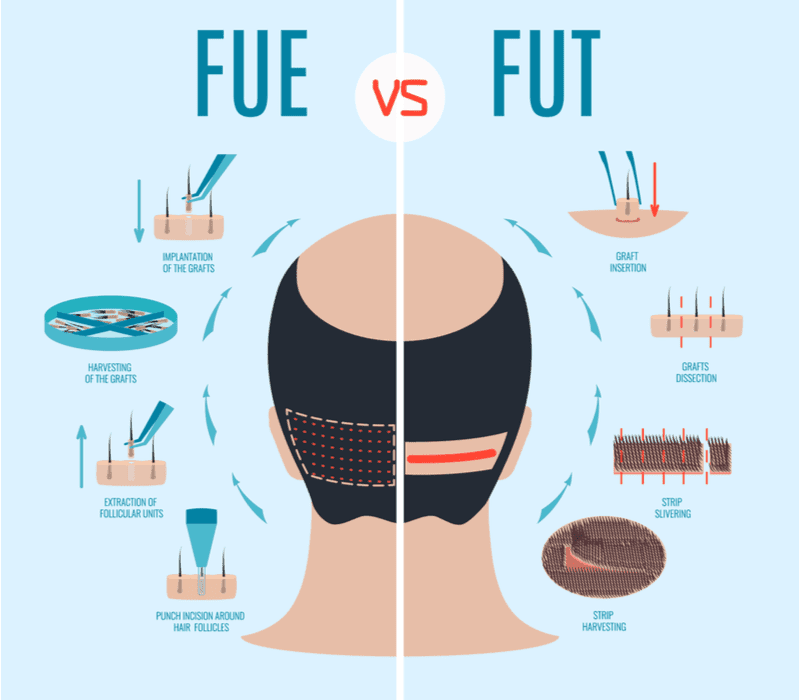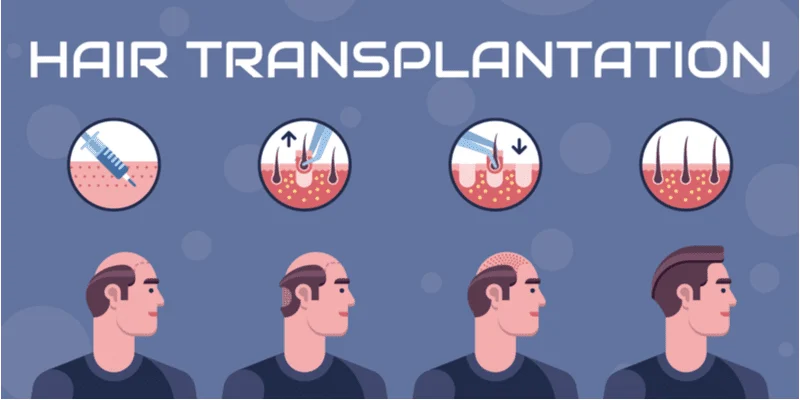Jump to:
If you have a receding hairline, a hair transplant can help restore fullness. If you’re seriously considering getting a hair transplant, don’t let hair transplant costs catch you by surprise; read on to learn about the price range, side effects, and everything else you need to know about hair transplants.
Hair Transplant Cost Guide
Hair transplants have come a long way since they were first performed in 1952. In those days, the hair plug technique was used, and the results weren’t exactly natural.
With old methods, large spaces between tufts of hair and obvious differences in hair growth patterns made it obvious when patients had a hair transplant. Thankfully, that’s no longer the case.
Today’s hair transplants look natural, take less time to heal, and solve problems like overall thinning, bald patches, and receding hairlines. But the cost of hair transplants is a limiting factor for many people.
The procedure can cost thousands of dollars – anywhere from $2,000 to $20,000 – depending on the technique used to perform the transplant. Your cost may be lower depending on:
- Your area
- How many grafts you need
- The surgeon’s expertise
We’ll cover everything you should know about hair transplants, including hair transplant cost, the surgery process, possible side effects, top alternatives, and how to determine if this procedure is right for you in this guide. Let’s start with cost.
Read Next: Should I Get a Hair Transplant?
How Much Do Hair Transplants Cost?
Hair transplants may be the best cure for thinning or balding hair, but the procedure isn’t cheap. So how much do hair transplants actually cost?
The cost of a hair transplant ranges from $2,000 to as much as $20,000 per session. Expect to pay these costs out of pocket, as most insurance companies consider this a cosmetic procedure.
That’s a wide price range. This is because there are so many cost factors in play when you get a hair transplant. This includes everything from:
- Location of your transplant
- Your travel costs
- Number of grafts you need
- Skill level of your surgeon
- Your insurance coverage
- Any specials or discounts
Here’s more info on the factors that affect how much a hair transplant costs. And be sure to read to the very end — it’ll save you a lot of time and headache during the research process.
Hair Transplant Cost Factors
While the average cost range is anywhere from $2,000 to $20,000 for a hair transplant, your cost might be lower or higher depending on these factors.
1. Number of Grafts

Halit Omer/Shutterstock
The number of hair grafts you get in a session is the biggest cost factor for a hair transplant. Your surgeon will work with you to decide how many grafts you’ll need to get the results you’re looking for.
More grafts cost more overall but are typically priced lower per graft ($2-$5/graft). Fewer grafts cost less overall but are priced higher per graft ($5-$10/graft). In a single session, the maximum number of grafts that can be transplanted is about 4,000.
Each graft contains a group of 1-4 hairs. So, you can expect about 6,000 hairs to be transplanted in one session, at most. But not all patients undergoing this surgery need the maximum number of grafts that can be transplanted.
If you need fewer grafts or are taking advantage of a “lunchtime special,” where about 200 grafts are transplanted in a short period of time, your cost will be on the lower end.
2. Location
The location you’re in has a lot to do with how much your hair transplant will cost. The average cost of living in your area is a good indicator of how much a transplant might be. High cost of living generally means the cost of the surgery will be on the higher end and vice versa.
But keep in mind that if you’re in an area with very few surgeon options, there’s less competition and you might find that your surgeon charges an average to high amount.
If you’re in an area with lots of hair transplant surgeon options, you may be likely to find lower hair transplant costs regardless of a higher cost of living. This is because there are more surgeons regularly performing the procedure. In other words, more competition.
In some cases, there may be no surgeons performing hair transplants in your area and you’ll need to travel to have the procedure done.
3. Hair Transplant Technique

Art4stock/Shutterstock
Hair transplants today are done with one of two techniques: Follicular Unit Transplantation (FUT) or Follicular Unit Extraction (FUE). Their costs are different, so pay attention to which type of procedure the surgeon you’re considering uses.
FUT hair transplants are less expensive. FUT involves the surgeon removing a strip of the scalp (or in rare cases, from another area) to extract follicles from it. Then, the extracted follicles are transplanted to the areas where you want increased fullness.
FUT procedures leave long linear scars on the scalp. But these scars will be covered by your hair when it grows back in.
FUE hair transplants are more expensive. FUE involves the surgeon removing individual follicular units straight from the scalp without taking a large strip. This procedure leaves small, scattered, barely noticeable scars on the scalp. These scars will be covered by your hair when it grows back in.
4. Surgeon Skill
If you’ve ever been to a cheap salon and gotten a bad haircut, you know very well how skill and experience correlates with the overall cost of a service. Hair transplants are no different.
The skill level of the surgeon performing your surgery will affect how much the procedure will cost. Good surgeons know they can give you quality results that you’ll love and are careful to transplant your follicles in a natural and attractive way.
This is why skilled surgeons will always charge more than inexperienced surgeons or those who rush through the procedure without concern about the results.
So, if you’ve heard great things about a well-known surgeon in your area who does great work, know that their price won’t be cheap – but the results will be worth it.
5. Insurance Coverage

Valeri Potapova/Shutterstock
If you’re planning to submit a claim to your insurance provider for a hair transplant to cut the out-of-pocket cost, you’ll be disappointed. Hair transplants are considered a cosmetic procedure that is not medically necessary.
That means 99.9% of the time (with the exception being a serious accident requiring reconstructive surgery on your scalp) your insurance will not cover hair transplants. You’ll be paying for the procedure out of pocket.
6. Travel and Recovery
Don’t forget about the embedded costs of travel and recovery. If you can’t find a qualified surgeon in your area, or plan to travel to have the procedure done by a particular surgeon, you may incur costs from airfare, gas, car rental, hotel rooms, and food while you’re travelling.
Recovery time is important to consider when you’re calculating costs, too. It takes a few days to recover fully from a hair transplant, so you’ll need to take some time off work.
If you’re not in a salaried position or can’t take paid time off, factor those missed days at work into the total cost of your hair transplant. You will also need pain medication and antibiotics during recovery, which may or may not be covered by your insurance.
How Hair Transplants Are Done
Now that we’ve looked at the average cost of hair transplants and the factors that affect it, let’s take a more detailed look at how the procedure is done. This will help you know what to expect if you decide to move forward.
1. Prep and Numbing

New Africa/Shutterstock
The first steps of a hair transplant are preparatory. Your surgeon may need to trim or shave the section of the scalp where follicles will be harvested. Your scalp will be cleaned and then numbed with a local anesthetic.
If you’re having the FUT (follicular unit transplantation) procedure, you may not need your hair trimmed before the procedure.
2. Follicle Harvesting
Once the surgeon is certain that your scalp is numb, they will begin harvesting follicles from hair-bearing portions of your scalp. That’s usually the back of the head.
If the FUT technique is used, a long strip of scalp will be removed, then cut into smaller sections to be transplanted. The strip will be closed with stitches.
If the FUE technique is used, a small, motorized tube-like instrument will be used to quickly extract tiny circular sections of the scalp with 1-4 follicles in each section. This method doesn’t require stitches.
3. Follicle Implantation

Graphicwithart/Shutterstock
After the follicles have been extracted from a healthy area of the scalp using the FUT or FUE method, the follicles are transplanted to the areas with hair loss. That might be your hairline, crown, or a thinning patch elsewhere on the head.
Tiny slits are cut into the scalp in the desired area. Then, the healthy follicles are inserted into the slits to take root and begin growing to fill out the area. This is repeated for as many follicular units as the surgeon extracted in the follicle harvesting step.
4. Recovery
After the surgery, you’ll have a little more waiting to do. Results aren’t immediate. Usually, the transplanted hair will fall out 2-3 weeks after surgery and regrow from the new follicle root.
This can take several months before you see the full results of the transplant. Recovering from a hair transplant involves taking antibiotics, anti-inflammatory medication, and pain medication.
Most patients are able to go back to work 2-5 days later. While you’re recovering, you’ll need to pay extra attention to protecting your scalp and the newly transplanted follicles.
Even rubbing your head on the pillow at night can cause friction that makes the new hairs fall out. Showering has to be done with care and the scalp must be kept clean to avoid infection.
How Long Do Hair Transplants Take?

Satyrenko/Shutterstock
Hair transplants take several hours. You can expect to spend anywhere from 5-8 hours in the medical facility when you get a hair transplant, and longer recovering from it.
Even so-called “lunchtime hair transplants” or “lunch hour hair transplants” will take several hours because of the painstaking detail that must go into it.
It takes time to prep, numb, harvest follicles, and insert follicles in a natural pattern. So, while 5-8 hours may sound like a long time, this is not a procedure you want your surgeon to rush through!
Do Hair Transplants Hurt?
Hair transplants don’t typically hurt, but some patients say they feel mild discomfort during the procedure. Since hair transplants are usually performed under local anesthesia, you’ll be awake and aware of the procedure but unable to feel it.
It’s painless enough that most surgeons have their patients watch movies and rest while the transplant is being performed. One patient described the feeling of implantation while under a local anesthetic:
“The sensation of the hairs being re-planted felt a bit like being prodded in the scalp with a biro, which was a small price to pay for reversing years of cruel shedding.”
Pain after the procedure is more noticeable, but your surgeon will prescribe you anti-inflammatory medication and pain medication to keep you comfortable while the transplanted follicles heal.
Best Hair Transplant Alternatives

ZikG/Shutterstock
If the cost seems too high or the procedure doesn’t seem right for you, there are alternatives to hair transplants. Here are the best alternatives to consider.
- Minoxidil (Rogaine): This is a very popular treatment for thinning hair. It works for men and women and creates more fullness in the hair by increasing the size and health of hair follicles. You usually don’t need a prescription to buy this OTC product.
- Finasteride (Propecia): This medication can treat male and female pattern baldness as well as enlarged prostate. It blocks production of a male hormone that inhibits hair growth. You need a prescription for this medication.
- Laser Therapy: Low-level laser therapy reactivates follicles to begin producing hair again. It also strengthens the existing follicles and increases hair retention over time.
Are Hair Transplants Right for You?
With all this information in mind, are hair transplants going to be the right choice for you? That depends. Here’s what you should consider.
- Donor hair health: You’ll need healthy, strong donor hair to get hair transplants. If you’re experiencing hair loss in the donor areas (usually the back of the head), you may not be a good candidate for a hair transplant.
- Male or female pattern baldness: Men and women can both benefit from hair transplants, but male pattern baldness (androgenetic hair loss) is the better candidate for this procedure. However, about 27% of hair transplants are performed on women, so don’t discount the possibility if you have female pattern baldness.
- Hair type: Coarse, light-colored hair is the best candidate for hair transplantation. Fine, dark hair requires more transplanted follicles to get that full, natural look. Keep this in mind if you have fine, dark hair.
- Desired results: Hair transplants help thinning and balding hair, but they’re not a 100% cure. Some of the transplanted hair will fall out after the surgery and just about 10% to 80% of transplanted hair will fully grow back after the shedding period. So, if you’re expecting a miracle, you need to understand that hair transplants aren’t going to do it. If you’re expecting less obvious thinning and more fullness, you’re right on track and hair transplants might be perfect for you.
- Budget: Hair transplants aren’t cheap, and you’ll spend anywhere from $2,000 to $20,000 for this procedure. If budget is important, you might consider getting fewer follicles transplanted to see how you like the results. You can also try any of the lower-priced alternatives we listed above.
Hair transplants don’t have to be obvious. When done by a skilled surgeon and cared for properly post-surgery, they look natural and restore some of your hair’s youthful fullness.
If you’re sick of thinning hair, meet the criteria above, and are ready to love your hair again, hair transplants just might be the solution you need.
